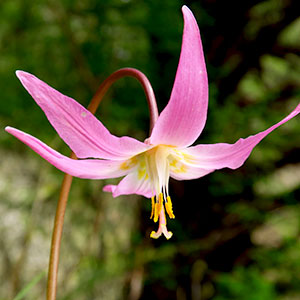Erythronium quinaultense
Erythronium revolutum
fawnlily, Olympic fawn-lily, quinault fawn-lily, quinault trout-lily
coast fawn lily, mahogany fawn lily, pink fawn-lily
narrowly ovoid, 35–75 mm.
narrowly ovoid, 35–50 mm, sometimes producing sessile offsets.
12–20 cm;
blade green or faintly mottled with white or brown, lanceolate to ovate, margins ± wavy.
10–25 mm;
blade distinctly mottled with irregular streaks of brown or white, broadly lanceolate to ovate, margins entire to ± wavy.
12–25 cm.
15–40 cm.
1–3-flowered.
1–3-flowered.
tepals white proximally, shading to pink at outer margins, darkest toward tips, with yellow band at base, lanceolate to narrowly ovate, 30–50 mm, inner with small auricles at base;
stamens 12–24 mm;
filaments white, flattened, slightly widened, linear to lanceolate, 1–2 mm wide;
anthers yellow;
style white, 10–18 mm;
stigma with slender, usually recurved lobes 1–5 mm.
tepals uniformly clear violet-pink at anthesis, with yellow banding at base, lanceolate to narrowly elliptic, 25–40 mm, inner with small auricles at base;
stamens ± appressed to style, 12–22 mm;
filaments white to pink (darkening with age), flattened, ± lanceolate, 2–3 mm wide;
anthers bright yellow;
style white to pink, 12–18 mm;
stigma with slender recurved lobes 4–6 mm.
oblong to obovoid, 3–6 cm.
oblong to obovoid, 3–6 cm.
= 48.
Erythronium quinaultense
Erythronium revolutum
Erythronium quinaultense is a tetraploid species apparently derived from hybridization between E. montanum and E. revolutum. It is known only from the southwestern Olympic Peninsula.
(Discussion copyrighted by Flora of North America; reprinted with permission.)
- Local floras:
BC,
CA,
OR,
WA
- Local Web sites:
CalFlora,
CalPhotos,
Flora NW,
PNW Herbaria,
Turner Photog.
WildflowerSearch
iNaturalist (observations)
USDA Plants Database
- LBJ Wildflower Center
- SEINet
- Plants of the World Online
- Encyclopedia of Life
- Wikipedia
- Google Image Search


